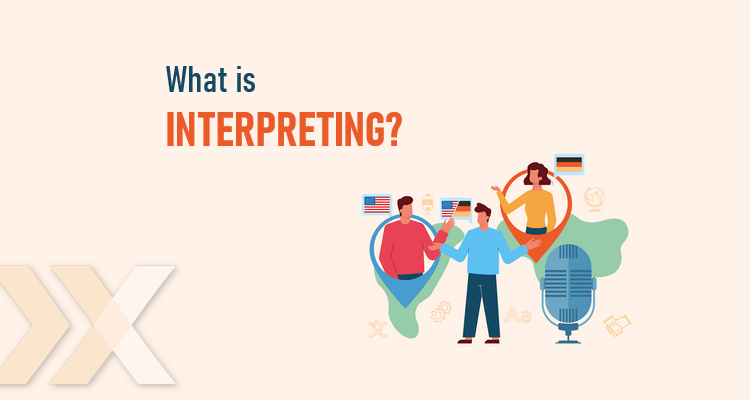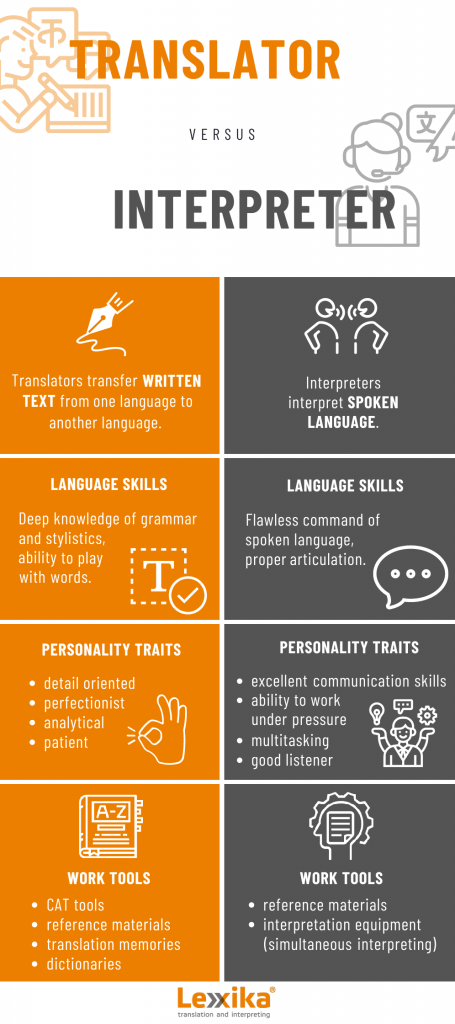
Much like written translation, interpreting facilitates both intracultural and intercultural communication. People often confuse the two translation concepts, but the differences go far beyond the simplistic dichotomy of oral vs written translation.
What is interpreting?
Interpreting frequently falls under the more well-known umbrella term – translation. Focus typically falls on the spoken aspects of interpreting when defining the concept, and so it is often described as oral translation. The difference in the medium of transfer is undoubtedly the most characteristic feature of interpreting. Nevertheless, it does not encompass all of its nuances.
Apart from the communication media, translation and interpreting paths also diverge when it comes to language skills, personality traits, and work tools. Interpreting, understood as the oral reproduction of spoken language, requires the mastery of specific skills that are not emphasised in standard translation practice:
- Language skills – excellent pronunciation and articulation, perfect command of the spoken language
- Personality traits – multitasking, great receptive skills, mental toughness, well-developed soft skills
- Work tools – interpreting booth equipment (simultaneous interpreting), termbases and reference materials
Interpreting skills also vary depending on the interpreting mode. Two main types of interpreting exist – simultaneous and consecutive.
Types of interpreting
When asked about interpreting, people rarely have the same image in mind. Some imagine interpreters in a booth at a conference (simultaneous interpreting), while others see a person who alternates with the speaker in a political debate (consecutive interpreting). At this surface level, most people recognise these two primary interpreting modes, and they might find it challenging to indicate any differences between them. Here are some key distinctions:
- Simultaneous interpreting – usually requires special interpreting equipment (booths, console, headphones, etc.). The interpreter must have excellent short-term memory, receptive and productive skills, and specialist knowledge of the given work tools.
- Consecutive interpreting – an interpreting mode in which the interpreter and speaker(s) take turns. This often requires interpreting notes and segmenting the input – getting across the crucial parts while leaving behind the unnecessary.
This short summary provides a rough idea of what interpreting is, but if you are interested in more, we have provided a more detailed explanation of both modes in one of our previous articles.
Moreover, these interpreting modes can be further divided into subcategories. For example, conference interpreting (booth interpreting) is notably different from chuchotage (whispered interpreting), even though both fall into the same category – simultaneous interpreting.
Consecutive interpreting also includes two other subcategories; ‘high consecutive’ and ‘low consecutive’. High consecutive involves interpreting longer time intervals (e.g., twenty minutes). On the other side of the spectrum, low consecutive deals with shorter time intervals, for example, interpreting after only a couple of words or sentences.
However, other types of interpreting exist that don’t quite fit the previous definitions. That is because we divide interpreting types depending on our focal point – time, setting, equipment, etc. – and thus interpreting services are created.
Interpreting services and other interpreting types
Strictly speaking, all interpreting is conducted either consecutively or simultaneously. But that doesn’t stop translation scholars, who are always hunting for new definitions and divisions! In addition to the consecutive and simultaneous modes, interpreting can be divided based on interpreting services, such as:
- Sign language interpreting – contrary to the view of interpreting as oral translation, this type shows that spoken language is not necessarily what differentiates interpreting from translation. This type can occur between two or more sign language systems or between a spoken language and a sign language.
- Over-the-phone interpreting – a type of remote interpreting via telephone that is mainly used in situations where face to face communication is not possible.
- Video remote interpreting – a service for deaf and hard of hearing people that utilises video conferencing technology to help overcome the communication barrier. However, the COVID-19 pandemic has associated this interpreting type with online video conferences and meetings.
- Sight translation – combines written input with spoken output. The interpreter is silently reading a source language text while speaking (interpreting) in the target language.
- Sworn/certified interpreting – certified interpreters usually offer all types of interpreting services. In Slovakia, they are appointed by the Ministry of Justice of the Slovak Republic, and their services are mostly requested in court.
- Public service interpreting – essentially interpreting for the public sector – healthcare providers, courts, police, immigration offices, Public service interpreters frequently form the bridge between minority language communities and local authorities.
- Relay interpreting – while not an interpreting type per se, it is a technique used when missing an interpreter with the required language combination. For example, if there are a German/English interpreter and a Chinese/English interpreter at a conference, but the requested language combination is German/Chinese, both interpreters can use English as the third language to fill the gap.
- Liaison interpreting – predominantly used in a business setting when the interpretation occurs bi-directionally.
- Travel interpreting – travel/escort interpreters fulfil the role of an interpreter and travel guide They accompany the client and help them on their trip.
Interpreting services clearly come in many colours. Scholarly books and internet blogs overflow with numerous classifications and definitions, but the critical distinction between consecutive and simultaneous modes remains the same. If you want to see the interpreting services we offer, click here.
Interpreting and translation
It has already been stated that translation and interpreting are not identical.

Our infographic demonstrates how interpreters need different training and skills than translators, but are they really that different?
One way to answer this is by looking at the market. The interpreting market shows the first sign of dissimilarity long before participants even enter it. When translation studies graduates leave higher education, only a tiny portion of them will become interpreters. This is mainly because of the nature of interpreting – it is a demanding profession requiring true mastery in several different areas which don’t necessarily overlap with translation skills.
Interpreters are not only dynamic when working in a booth, but also flexible in other aspects of life. Freelance interpreters are constantly on the go, or at least they used to be. The COVID-19 pandemic has changed many professions, and interpreting is no exception. Five hotels per-month have been swapped for five video conferencing platforms. In this case, interpreters have become more like stereotypical translators – they had to learn to work from home.
But this is not to say that interpreters and translators are enemies with incompatible interests. In the end, translators and interpreters both share the love of languages! Both professions support one another, as they have coexisted for centuries in different forms.
Can you see any other differences between translators and interpreters? Do you notice a common thread binding both professions together? Don’t forget to leave your answer below!

I’ve been working in the language industry since 2016, primarily teaching Slovak and English while working on my Translation/Interpreting and Philosophy degree at MBU in Banská Bystrica. I’ve started as a freelance translator in early 2021. After gaining some experience in the field, I started working with LEXIKA as a part of the Mentoring Programme. Taking my first steps as a translator with LEXIKA reinforced my decision to fully dedicate myself to languages. I’m currently working on adding Spanish to my repertoire. My next steps are focused on improving my knowledge of markup and programming languages since technical competence is always desperately needed in the translation industry.
Share it!
 21.01.2022
21.01.2022